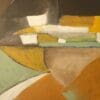Oil painting, with its rich textures and vibrant colors, has been a cornerstone of the art world for centuries. As a beginner, delving into this medium can be both exciting and rewarding. By understanding the essential techniques, you can embark on a creative journey that allows you to express your artistic vision with depth and beauty.
Preparing Your Canvas:
Before you start applying paint, it’s crucial to prepare your canvas properly. Make sure your canvas is stretched taut and primed with gesso to create a smooth surface that allows the paint to adhere effectively.
Underpainting: Building a Solid Foundation:
Begin your oil painting with an underpainting. This is a monochromatic layer that serves as a roadmap for your artwork. Use a thin wash of paint to establish the values and composition. A well-executed underpainting provides a strong foundation for the layers that follow.
Blocking In: Defining Shapes and Colors:
Once your underpainting is dry, start blocking in the main shapes and colors of your subject. Use a larger brush to establish the basic forms and their relationships. This stage is about capturing the essence of your subject and creating a rough outline.
Value Painting: Mastering Light and Shadow:
Understanding values is essential in oil painting. Focus on the interplay of light and shadow on your subject. Gradually build up different shades of a single color to depict volume and depth. For a comprehensive guide on values, check out this tutorial.
Layering and Blending: Adding Depth and Dimension:
Oil painting allows for the creation of stunning depth through layering and blending. Apply translucent layers of color, allowing the underlying layers to show through. Experiment with different brushes and techniques to achieve seamless transitions between colors.
Glazing for Luminosity:
Glazing involves applying a transparent layer of color over a dried layer. This technique adds a luminous quality to your painting and can modify colors subtly. Learn more about glazing and its effects here.
Impasto: Adding Texture and Drama:
Impasto involves applying thick layers of paint to create texture and a sense of three-dimensionality. This technique is excellent for adding drama and visual interest to your artwork. Experiment with palette knives and various brush strokes to achieve different textures.
Drying Time and Patience:
Remember that oil paints have a longer drying time compared to other mediums. This attribute allows for more flexibility in blending and layering but requires patience. Be mindful of your application to prevent muddiness and ensure that each layer has dried before applying the next.
Clean Brushes and Tools:
Regularly clean your brushes and tools to maintain the integrity of your colors. Use a solvent like odorless mineral spirits or safflower oil for cleaning, and make sure to properly store your tools to keep them in good condition.
Practice, Patience, and Passion:
As with any art form, mastering oil painting requires practice, patience, and a genuine passion for the craft. Don’t be discouraged by initial challenges. Embrace each painting as a learning opportunity, and over time, you’ll refine your skills and develop a unique artistic style.
Embark on your oil painting journey with confidence, armed with these fundamental techniques. Whether you’re painting serene landscapes, vibrant still lifes, or expressive portraits, mastering the basics of oil painting will empower you to create artwork that resonates with depth and emotion.
Disclaimer: The views and opinions expressed in this article do not necessarily reflect the official policy or position of Irish Artmart.




